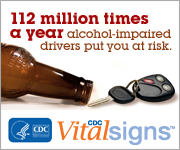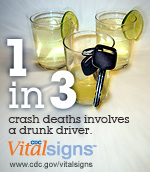Impaired Driving: Get the Facts
Every day, almost 30 people in the United States die in motor vehicle crashes that involve an alcohol-impaired driver. This amounts to one death every 48 minutes.1 The annual cost of alcohol-related crashes totals more than $51 billion.2
Thankfully, there are effective measures that can help prevent injuries and deaths from alcohol-impaired driving.
How big is the problem?
- In 2010, 10,228 people were killed in alcohol-impaired driving crashes, accounting for nearly one-third (31%) of all traffic-related deaths in the United States.1
- Of the 1,210 traffic deaths among children ages 0 to 14 years in 2010, 211 (17%) involved an alcohol-impaired driver.1
- Of the 211 child passengers ages 14 and younger who died in alcohol-impaired driving crashes in 2010, over half (131) were riding in the vehicle with the alcohol-impaired driver.1
- In 2010, over 1.4 million drivers were arrested for driving under the influence of alcohol or narcotics.3 That's one percent of the 112 million self-reported episodes of alcohol-impaired driving among U.S. adults each year.4
- Drugs other than alcohol (e.g., marijuana and cocaine) are involved in about 18% of motor vehicle driver deaths. These other drugs are often used in combination with alcohol.5

CDC Vital Signs: Drinking and Driving: A Threat to Everyone
US adults drank too much and got behind the wheel about 112 million times in 2010. Alcohol-impaired drivers* are involved in about 1 in 3 crash deaths, resulting in over 10,000 deaths in 2010.
*These drivers had blood alcohol concentrations of at least 0.08%. This is the illegal blood alcohol concentration level for adult drivers in the United States.
Who is most at risk?
- Young people:
- At all levels of blood alcohol concentration (BAC), the risk of being involved in a crash is greater for young people than for older people.6
- Among drivers with BAC levels of 0.08 % or higher involved in fatal crashes in 2010, more than one out of every 3 were between 21 and 24 years of age (34%). The next two largest groups were ages 25 to 34 (30%) and 35 to 44 (25%).1
- Motorcyclists:
- Among motorcyclists killed in fatal crashes in 2010, 28% had BACs of 0.08% or greater. 1
- Nearly half of the alcohol-impaired motorcyclists killed each year are age 40 or older, and motorcyclists ages 40-44 have the highest percentage of deaths with BACs of 0.08% or greater (44%).7
- Drivers with prior driving while impaired (DWI) convictions:
- Drivers with a BAC of 0.08% or higher involved in fatal crashes were four times more likely to have a prior conviction for DWI than were drivers with no alcohol in their system? (8% and 2%, respectively).1
A Closer Look
- Sobriety checkpoints: traffic stops where law enforcement officers assess drivers’ level of alcohol impairment. These checkpoints consistently reduce alcohol-related crashes, typically by 9%.
- Ignition interlocks: devices that are installed in the vehicles of people who have been convicted of driving while impaired. They prevent operation of the vehicle by anyone with a blood alcohol concentration (BAC) above a specified safe level (usually 0.02% – 0.04%). When installed, interlocks are associated with about a 70% reduction in arrest rates for impaired driving.
How can deaths and injuries from impaired driving be prevented?
Effective measures include:
- Actively enforcing existing 0.08% BAC laws, minimum legal drinking age laws, and zero tolerance laws for drivers younger than 21 years old in all states.3,8,9
- Promptly taking away the driver's licenses of people who drive while intoxicated.10
- Using sobriety checkpoints.11
- Putting health promotion efforts into practice that influence economic, organizational, policy, and school/community action.12,13
- Using community-based approaches to alcohol control and DWI prevention.10,14,15
- Requiring mandatory substance abuse assessment and treatment, if needed, for DWI offenders.16
Other suggested measures include:
- Reducing the illegal BAC threshold to 0.05%.17,18, 19
- Raising state and federal alcohol excise taxes.18, 20
- Mandatory blood alcohol testing when traffic crashes result in injury.18
Effects of BAC
What safety steps can individuals take?
Whenever your social plans involve alcohol, make plans so that you don’t have to drive after drinking. For example:
- Prior to any drinking, designate a non-drinking driver when with a group.
- Don’t let your friends drive impaired. Take their keys away.
- If you have been drinking, get a ride home or call a taxi.
- If you’re hosting a party where alcohol will be served, remind your guests to plan ahead and designate their sober driver; offer alcohol-free beverages; and make sure all guests leave with a sober driver.
References
- Dept of Transportation (US), National Highway Traffic Safety Administration (NHTSA). Traffic Safety Facts 2010: Alcohol-Impaired Driving. Washington (DC): NHTSA; 2012 [cited 2012 Sep 28]. Available at URL: http://www-nrd.nhtsa.dot.gov/Pubs/811606.PDF
- Blincoe L, Seay A, Zaloshnja E, Miller T, Romano E, Luchter S, et al. The Economic Impact of Motor Vehicle Crashes, 2000. Washington (DC): Dept of Transportation (US), National Highway Traffic Safety Administration (NHTSA); 2002.
- Department of Justice (US), Federal Bureau of Investigation (FBI). Crime in the United States 2010: Uniform Crime Reports. Washington (DC): FBI; 2011 [cited Sept 29 2012]. Available at URL: http://www.fbi.gov/about-us/cjis/ucr/crime-in-the-u.s/2010/crime-in-the-u.s.-2010/summary
- Bergen G. Shults RA. Rudd RA. (October 4, 2011). Vital Signs: Alcohol-Impaired Driving Among Adults –United States, 2010. Morbidity and Mortality Weekly Report. 60:39:1351.
- Jones RK, Shinar D, Walsh JM. State of knowledge of drug-impaired driving. Dept of Transportation (US), National Highway Traffic Safety Administration (NHTSA); 2003. Report DOT HS 809 642.
- Zador PL, Krawchuk SA, Voas RB. Alcohol-related relative risk of driver fatalities and driver involvement in fatal crashes in relation to driver age and gender: an update using 1996 data. Journal of Studies on Alcohol 2000;61:387-95.
- Paulozzi LJ, Patel R. Changes in motorcycle crash mortality rates by blood alcohol concentration and age — United States, 1983 - 2003. MMWR 2004;53(47):1103-6.
- Shults RA, Sleet DA, Elder RW, Ryan GW, Sehgal M. Association between state-level drinking and driving countermeasures and self-reported alcohol-impaired driving. Inj Prev 2002;8:106—10.
- Guide to Community Preventive Services. Reducing excessive alcohol use: enhanced enforcement of laws prohibiting sales to minors. [cited 2009 Nov 6]. Available at URL: www.thecommunityguide.org/alcohol/lawsprohibitingsales.html
- DeJong W. Hingson R. Strategies to reduce driving under the influence of alcohol. Annual Review of Public Health 1998;19:359-78.
- Elder RW, Shults RA, Sleet DA, et al. Effectiveness of sobriety checkpoints for reducing alcohol-involved crashes. Traffic Injury Prevention 2002;3:266-74.
- Howat, P, Sleet, D, Elder, R, Maycock, B. Preventing alcohol-related traffic injury: a health promotion approach. Traffic Injury Prevention, 2004;5:208-219.
- Hingson, R, Sleet, DA. Modifying alcohol use to reduce motor vehicle injury. In Gielen, Ac, Sleet, DA, DiClemente, R (Eds). Injury and Violence Prevention: Behavior change Theories, Methods, and Applications. San Francisco, CA: Jossey-Bass, 2006.
- Holder HD, Gruenewald PJ, Ponicki WR, et al. Effect of community-based interventions on high-risk drinking and alcohol-related injuries. Journal of the American Medical Association 2000;284:2341-7.
- Shults RA, Elder RW, Nichols J, et al. Effectiveness of multicomponent programs with community mobilization for reducing alcohol-impaired driving. American Journal of Preventive Medicine 2009; 37(4):360–371.
- Wells-Parker E, Bangert-Drowns R, McMillen R, et al. Final results from a meta-analysis of remedial interventions with drink/drive offenders. Addiction 1995;90:907-26.
- Howat P, Sleet D, Smith I. Alcohol and driving: is the .05% blood alcohol concentration limit justified? Drug and Alcohol Review 1991;10(1):151-66.
- National Committee on Injury Prevention and Control. Injury prevention: meeting the challenge. American Journal of Preventive Medicine 1989;5(3 Suppl):123-7.
- Wagenaar AC, Maldonado-Molina MM, Ma L, et al. Effects of legal BAC limits on fatal crash involvement: analyses of 28 states from 1976 through 2002. J Safety Res 2007 38:493-99.
- Guide to Community Preventive Services. Reducing excessive alcohol use: increasing alcohol taxes.
Get email updates
To receive email updates about this page, enter your email address:
Contact Us:
- Centers for Disease Control and Prevention
National Center for Injury Prevention and Control (NCIPC)
4770 Buford Hwy, NE
MS F-63
Atlanta, GA 30341-3717 - 800-CDC-INFO
(800-232-4636)
TTY: (888) 232-6348
New Hours of Operation:
8am-8pm ET/
Monday-Friday
Closed Holidays - cdcinfo@cdc.gov




